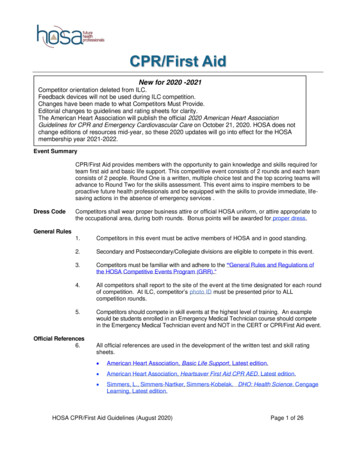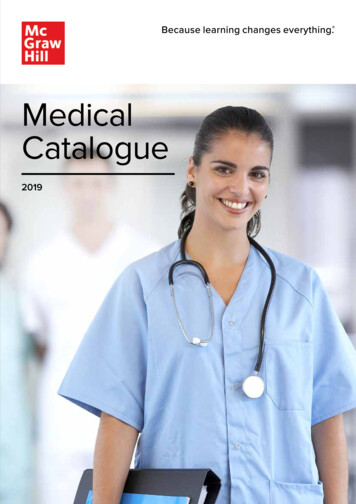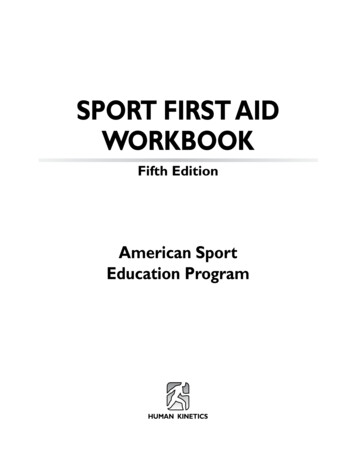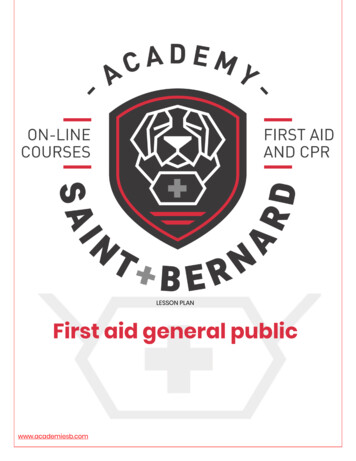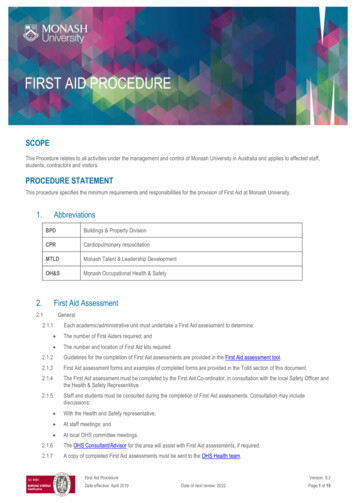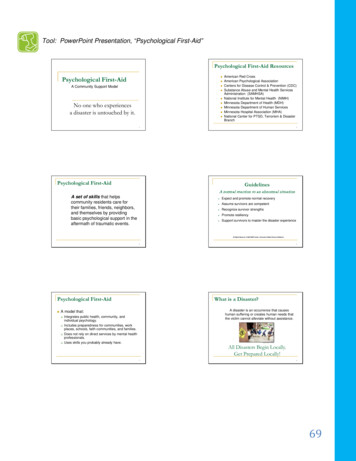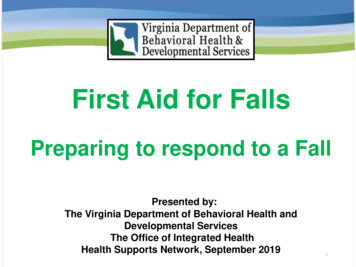
Transcription
First Aid for FallsPreparing to respond to a FallPresented by:The Virginia Department of Behavioral Health andDevelopmental ServicesThe Office of Integrated HealthHealth Supports Network, September 20191
PurposeThis training is brought to you from the Office ofIntegrated Health (OIH), Health Supports Network (HSN)Registered Nurse Care Consultants (RNCC)This training is best practice advice for community serviceproviders to help them to respond effectively when anindividual they serve experiences a fall.2
How to use this training. Welcome each participant. Turn off phones and reduce distractions. Review the purpose for the Training. Review the learning objectives. Hand out a piece of paper to each of the training participants andhave them complete the 5 question pre-test. Put the answers away until the end. Review and discuss the content on each slide. Have participants take out their pre-test answers. Review the answers and ensure each participant understands thecorrect answer.3
Key Terms & Abbreviations OIH: Office of Integrated Health ID/DD: Intellectual Disability/Developmental Disability MRE: Mobile Rehab Engineering RNCC: Registered Nurse Care Consultant DBHDS: Virginia Department of Behavioral Healthand Developmental Services AT: Assistive Technology DME: Durable Medical Equipment4
Learning ObjectivesAt the conclusion of this training,participants will be able to Define the term “fall”. List the possible complications of a fall. State one reason a health event that can cause anincrease risk for falls List five reasons to call 911. Describe why it is important to update the individual'sISP after a fall occurs.5
Pre - TestEach participant should answer the following questions and turn them overuntil the end of the training.1) True / FalseA fall is any situation in which someone descends (or falls)suddenly and involuntarily toward a lower surface or theground.2) True / FalseFall complications do not include broken bones, headinjuries, soft tissue damage, and problems with dailyactivities.3) True / FalseA change in any person’s health status never results in anincrease risk of falls.4) Calling 911 is important when you observe , ,, and .5) True / FalseThe individual who experienced a fall should have their ISPupdated because might need additional supports to limitand/or reduce their risk for a serious injury due to anotherfall.6
What is a Fall?A fall is any situation in which someonedescends (or falls) suddenly and involuntarilytoward a lower surface or the ground.Fall complications can include broken bones,head injuries, soft tissue damage, andproblems with daily activities (VCU, 2016).7
Fall DataThe Center for Disease Control (CDC)and Prevention reports (2019a,b,c; 2017)that in individuals 65 & over:Each year one in 4older adults will fall.Falls are the numberone cause of injuriesand death from injury.One out of five fallscauses a seriousinjury such as abroken bone or ahead injury.More than 95% of hipfractures are causedby falling.8
Fall FactsIn People with ID/DDAccording to research conducted by Hsieh, Rimmer, Heller, Minor and Grosso in 2014:One in five adults (18 – 44) with ID/DDreported falling in the past year.One in three middle-aged adults (45-64)with ID/DD reported falling in the pastyear.Nearly 25% of fall – related injuriesneeded medical attention.9
Fall FactsIn People with ID/DDAccording to research conducted by Hsieh, Rimmer, Heller, Minor and Grosso in 2014:Females have a higher prevalenceof falls than males.The prevalence of falls increases withadvancing age.Falls for adults with ID/DD were associatedwith having arthritis, seizure disorder,polypharmacy, using walking aids and lowerupper body extremity strength.10
Change in Health StatusWith a change in any person’s health status, especially those resulting from:EmergencyDepartment VisitUrgent Care VisitHospitalizationThere can be a new or increased risk for falls.Be sure to follow up with the individual’s Primary Care Provider(PCP) or licensed healthcare provider (ex. Nurse or PhysicalTherapist) to discuss their risk for falls.11
When a Fall Occurs When a Fall Occurs What Should You Do (Mayo Clinic, 2019a,b)? Assess immediate danger to all involved. Assess airway, breathing, andcirculation If the individual is not breathing, start CPR, call 911, and follow First Aid/CPRprotocols Is the individual conscious or unconscious (even for a short time)? If yes, theindividual should be assessed for concussion in the ER immediately, call 911 Does the individual have confusion, vomiting, or poor skin color? If yes, call911 If the individual has bleeding that will not stop with direct pressure over thewound, call 911 If the individual has a cut or burn that is large, deep, or one that involves thehead, chest, or abdomen, call 911 If the individual has skin or lips that look blue, purple, or gray, call 911 If the individual has a seizure (rhythmic jerking or loss of consciousness)immediately following the fall, call 91112
Signs of Serious InjuriesWhen a Fall Occurs What Should You Do (Mayo Clinic, 2019a,b)?Serious Injuries If the individual has an inability to move, call 911If the individual is having trouble breathing, or choking after a fall, call 911If the individual displays any lack of responsiveness, call 911If an individual (who can typically ambulate), can’t bear weight, call 911If the individual fell from any elevation or height (such as off a porch, a deck,a ramp, etc., call 911If the individual fell from any type of lift (a vehicular lift, a patient lift, etc.),call 911If the individual is involved in any type of DME-related falls (falls from amanual wheelchair, a power wheelchair, a stander, a gait trainer, a lift, etc.),call 911If the individual falls out of a vehicular seat, (and/or is thrown) during anytype of vehicular accident, (or falls “out of” a vehicle), call 911If you observe excessive swelling to any area of the individual’s body or anylimb (legs, arms, etc.), after a fall, call 91113
Signs of Serious Head InjuriesCall 911 or your local emergency number if any of the following signs orsymptoms are apparent after a fall, because they may indicate a moreserious head injury (Mayo Clinic, 2019a,b):Indicators of Serious Head Injury in Adults Severe head or facial bleeding Bleeding or fluid leakage from the nose or ears Severe headache Any change in level of consciousness Black-and-blue discoloration below the eyes or behind the ears Cessation of breathing Confusion Loss of balance Weakness or an inability to use an arm or leg Unequal pupil size Slurred speech A seizure14
Let’s Review Follow First Aid guidelines for immediate care Seek immediate follow – up care & evaluation Call 911 after a Fall If any injury is suspected such as, head injury,broken bones, traumatic brain injuries, etc. If there is ANY question of possible injury(Mayo Clinic, 2019, a,b)15
After a FallIf the individual experiences a fall, what should you do?After a fall - don’t wait. Inform the team members on the individual’scare team, as soon as possible. The individual might need additionalsupports to limit and/or reduce their risk for a serious injury due toanother fall. Develop a plan to address the risk(s) and reduce the possibility ofa future fall with the care team. Conduct an ISP meeting to identify any referrals or interventionsthat might be appropriate. Update the individual’s Individualized Support Plan (ISP).16
In the End Caregivers need to try their best to determine if achange they observed could affect the individual’shealth, their functional status and/or the delivery ofservices that are planned.Consider the following: Are more/different supports needed? Does the individual require a different type ofsupport? (Hsieh, Rimmer, Heller, Minor and Grosso in 2014)17
Who Can Help Plan?There are a number of healthcare professionals that canprovide assessment and prescription for treatment toreduce the risk of possible adverse events (Hsieh, Rimmer,Heller, Minor and Grosso in 2014).They include: Primary Care Practitioner (PCP) Orthopedist Podiatrist Neurologist Ophthalmologist Ear, Nose & Throat Specialist18
Who Else Can Help?Other healthcare professionals that can assess andprovide a care plan (in their specialty) addressing theprescribed treatment(s) to reduce the risk of falls, include: Registered Nurse (RN) Licensed Practical Nurse (LPN) – per VA BON Regulations Pharmacist Physical Therapist (PT) Occupational Therapist (OT) Certified Therapeutic Recreation Specialist (CTRS) Behavioral Support Professional (BCBA, BSP)(Hsieh, Rimmer, Heller, Minor and Grosso in 2014)19
Who else can help?Other professionals that can help identifyresources in the community include: The DBHDS/OIH MRE Team Individual’s selected DME Provider MCO Care Coordinator DBHDS: Office of Integrated Health (OIH):Registered Nurse Care Consultants (RNCCs)20
DBHDS Mobile Rehab Engineering TeamHaving properly workingdurable medicalequipment (DME) isimportant for reducingrisk of falls.DBHDS, Office of Integrative Health has a MobileRehab Engineering (MRE) Team program, whichensures that individuals who rely on durable medicalequipment (DME) (such as wheelchairs, shower chairs,gait trainers, standers, patient lifts, etc.), have access tomaintenance and repair services if they do not havethose services currently available to them.For more information: email the MRE Team at:mreteam@dbhds.virginia.gov21
DBHDS Mobile Rehab Engineering TeamIf you see anything broken on a wheelchair, such as: A broken partMissing or loose bolts, screws, brackets, clasps, etc.Missing or torn seat belts or chest harnessesMissing armrestsRipped vinyl on seat bottoms or backs (the individual could fall through)Loose cushions (the individual could slip to the floor)Loose or wobbly wheelchair brakes (that don’t keep the tires from moving)Footrests that don’t work properly and/or are missingParts that are loose and/or wobblyMissing clothing guards (longer garments such as ponchos or sweaters can getcaught in the wheel spokes and can yank an individual to the floor)Email the MRE Team as soon as possible at:mreteam@dbhds.virginia.gov22
DBHDS Mobile Rehab Engineering TeamIf you see any assistive technology (AT) devices, such as helmets,Knee/Ankle/Leg/Foot or Hand orthotics with: Broken or missing fasteners (clasps, buckles, brackets, etc.) Broken or missing parts (screws, bolts, rivets, etc.) Torn or missing straps Worn out or missing Velcro Worn out or missing paddingEmail the MRE Team as soon aspossible at:mreteam@dbhds.virginia.gov23
DBHDS Resources OIH Health and Safety Alerts- -health/safety-alertsarchive- Fall Prevention (September, 2019)- First for Falls (September, 2019) OIH Newsletters- -health/safety-alerts-archive OIH Mobile Rehab Engineering Team / Power PointEmail: mreteam@dbhds.virginia.gov DBHDS Guidance Document §12 VAC 35-105-720.B24
Office of Integrated HealthResources25
Pre – test AnswersEach participant should turn over their pre-test answer sheet and as agroup review the answers listed below:1) True2) False3) False4) Call 911 when any of the following is observed confusion, vomiting,poor skin color, bleeding that will not stop with direct pressure, cut orburn that is large or deep, skin or lips that look blue, purple, or gray,has a seizure, has an inability to move, trouble breathing, or choking,any lack of responsiveness, can’t bear weight, fell from any elevationor height, fell from any type of lift, involved in any type of DME-relatedfalls, falls involving a vehicle, excessive swelling to any area of theindividual’s body or any limb and / or you have reason to suspectsevere injury.5) True26
References & ResourcesAmerican Academy of Pediatrics (2018). Concussion management: Return to play. Retrieved state-advocacy/Documents/Concussion.pdfAmerican Medical Society for Sports Medicine (2005). Sport Concussion Assessment Tool. Retrievedfrom http://www.amssm.org/MemberFiles/SCAT v13- Side 2.docAmerican Red Cross (2016), Traumatic injuries (pp. 110-111). First Aid/CPR/AED Instructors Manual.USA: Staywell.Bhangu, J., McMahon, C. G., Hall, P., Bennett, K., Rice, C., Crean, P., . & Kenny, R. A. (2016). Longterm cardiac monitoring in older adults with unexplained falls and syncope. Heart, 102(9), 681-686.Brain Injury Association of Virginia (2013). Brain injury and the schools: A guide for educators.Retrieved fromhttp://www.doe.virginia.gov/special ed/disabilities/traumatic brain injury/brain injury schools.pdfBrain Injury Association of Virginia (2019). Concussion: Mild traumatic brain injury in the elderly.Retrieved from https://www.biav.net/?s concussionCareerforce (2017). Learning guide: Observe and respond to changes. Retrieved 0Assessment%20Resources/LG27459-2.1.docCenter for Disease Control and Prevention. (2017). Home and recreational safety: Important factsabout falls. Retrieved falls/adultfalls.htmlCenters for Disease Control and Prevention (2013). What is a concussion? Retrieved fromhttps://www.youtube.com/watch?v Sno 0Jd8GuA&feature youtu.be27
References & ResourcesCenters for Disease Control and Prevention, (2019c). Heads up. Retrieved -head-trauma/basics/art-20056626Centers for Disease Control and Prevention, National Center for Injury Prevention and Control. (2019d).Web–based injury statistics query and reporting system (WISQARS).Children’s Hospital of the King’s Daughters (CHKD) (2019). Could it be a concussion? Retrieved hildren’s National Health System (2019). Concussion FAQ’s. Retrieved ducation-score-program/concussion-faqsGioia, G. and Collins, M. (2005). Acute concussion evaluation. Retrieved -a.pdfMayo Clinic (2019a). Cuts and scrapes: First aid. Retrieved from /basics/art-20056711Mayo Clinic (2019b). Head trauma: First aid. Retrieved from -trauma/basics/art-20056626Office of Integrated Health, Virginia Department of Behavioral Health and Developmental Services (n.d.).Documenting changes in a person’s status. Retrieved 20medical%20condition.pdf28
References & ResourcesVirginia Board of Education (2016). Virginia Board of Education guidelines for policies on concussions instudents. Retrieved from ts.pdfVirginia Commonwealth University (2016). Orientation Manual for Direct Support Professionals (DSPs) andSupervisors: Supporting people in their homes and communities. Retrieved fromhttps://partnership.vcu.edu/DSP orientation/downloadables/SECTION%206 07222016.pdfVirginia Department of Behavioral Health and Developmental Services (DBHDS), Commonwealth ofVirginia Government (2016). Orientation manual for direct support professionals (DSPs) and supervisors:supporting people in their homes and communities [Brochure]. Retrieved fromhttps://partnership.vcu.edu/DSP al%20%20REVISED 08102016 with%20test effective%20date09012016.pdfVirginia Department of Health (2019). Concussion: What is a concussion? Retrieved jury/concussions/29
Still Have Questions?OR Comments?Please contact:The Virginia Department ofBehavioral Health andDevelopmental Disability(DBHDS)Office of Integrated -integrated-health#30
31
Follow First Aid guidelines for immediate care Seek immediate follow – up care & evaluation Call 911 after a Fall If any injury is suspected such as, head injury, broken bones, traumatic brain injuries, etc. If there is
